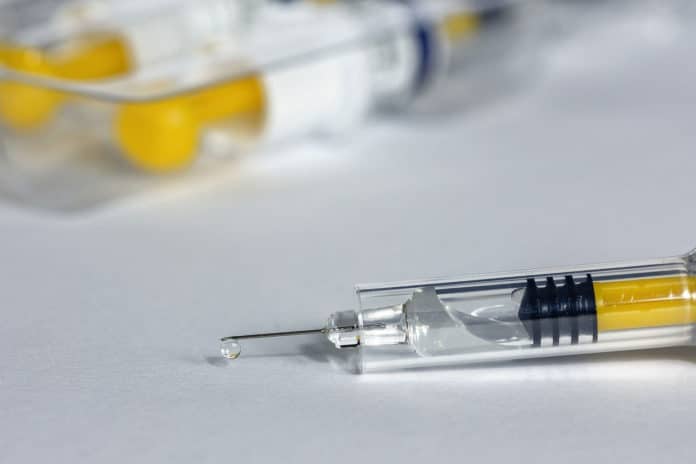The first COVID-19 vaccine called adenovirus type-5 (Ad5) vectored COVID-19 vaccine that underwent a phase 1 clinical trial found to be safe, well-tolerated and can create a faster immune response against SARS-CoV-2 in humans.
108 healthy adults aged between 18 and 60 years were sequentially enrolled in the study. The open-label trial in these individuals shows promising results after 28 days, yet the final results will take six months.
Professor Wei Chen, from the Beijing Institute of Biotechnology in Beijing, China, who is responsible for the study, said, “These results represent an important milestone. The trial demonstrates that a single dose of the new adenovirus type 5 vectored COVID-19 (Ad5-nCoV) vaccine produces virus-specific antibodies and T cells in 14 days, making it a potential candidate for further investigation. However, these results should be interpreted cautiously. The challenges in the development of a COVD-19 vaccine are unprecedented, and the ability to trigger these immune responses does not necessarily indicate that the vaccine will protect humans from COVID-19. This result shows a promising vision for the development of COVID-19 vaccines, but we are still a long way from this vaccine being available to all.”
Authors noted, “Creating an effective vaccine is a long-term solution to controlling the COVID-19 pandemic.”
The new Ad5 vectored COVID-19 vaccine assessed in this trial is the first to be tested in humans. It utilizes a weakened common cold virus to convey genetic material that codes for the SARS-CoV-2 spike protein to the cells. These cells then produce the spike protein and travel to the lymph nodes where the immune system makes antibodies that will recognize that spike protein and ward off the coronavirus.
The aim of the study to assess the safety and ability of the new Ad5-nCoV vaccine. The participants received either a single intramuscular injection of the new Ad5 vaccine at a low dose (5 × 1010 viral particles/0·5ml, 36 adults), middle dose (1×1011 viral particles/1.0ml, 36 adults), or high amount (1.5 x 1011 viral particles/1.5ml, 36 adults).
Scientists tested the volunteers’ blood at regular intervals. They observed whether the vaccine stimulated both arms of the immune system: the body’s ‘humoral response’ (the part of the immune system that produces neutralizing antibodies which can fight infection and could offer a level of immunity), and the body’s cell-mediated arm (which depends on a group of T cells, rather than antibodies, to fight the virus).
Scientists found that all volunteers well tolerated the doses with no serious adverse events. Most adverse events were mild or moderate, with 83% (30/36) of those receiving low and middle doses of the vaccine and 75% (27/36) in the high dose group reporting at least one adverse reaction within seven days of vaccination.
The most common adverse reactions were mild pain at the injection site reported in over half (54%, 58/108) of vaccine recipients, fever (46%, 50/108), fatigue (44%, 47/108), headache (39%, 42/108), and muscle pain (17%, 18/108). One participant, given the higher dose vaccine, reported severe fever along with severe symptoms of fatigue, shortness of breath, and muscle pain. However, these adverse reactions persisted for less than 48 hours.
Within two weeks of vaccination, all dose levels of the vaccine triggered some level of the immune response in the form of binding antibodies (that can bind to the coronavirus but do not necessarily attack it – low-dose group 16/36, 44%; medium dose 18/36, 50%; high dose 22/36, 61%), and some participants had detectable neutralizing antibodies against SARS-CoV-2 (low-dose group 10/36, 28%; medium dose 11/36, 31%; high dose 15/36, 42%).
After 28 days, most participants had a four-fold increase in binding antibodies (35/36, 97% low-dose group; 34/36 (94%) middle-dose group, and 36/36, 100% in high-dose group), and a half (18/36) of participants in the low- and middle-dose groups and three-quarters (27/36) of those in the high-dose group showed neutralizing antibodies against SARS-CoV-2.
Meanwhile, the Ad5-nCoV vaccine also simulated a rapid T cell response in the majority of volunteers.
Furthermore, after 28 days, the majority of recipients showed either a positive T cell response or had detectable neutralizing antibodies against SARS-CoV-2 (low-dose group 28/36, 78%; medium-dose group 33/36, 92%; high-dose group 36/36, 100%).
Authors noted, “However, both the antibody and T-cell response could be reduced by high pre-existing immunity to adenovirus type 5 (the common cold virus vector/carrier)–in the study, 44%-56% of participants in the trial had high pre-existing immunity to adenovirus type 5 and had a less positive antibody and T-cell response to the vaccine.”
Professor Feng-Cai Zhu from Jiangsu Provincial Center for Disease Control and Prevention in China, who led the study, said, “Our study found that pre-existing Ad5 immunity could slow down the rapid immune responses to SARS-CoV-2 and also lower the peaking level of the responses. Moreover, high pre-existing Ad5 immunity may also have a negative impact on the persistence of the vaccine-elicited immune responses.”
Although, scientists think that more research is required before this trial vaccine becomes available to all.
Journal Reference:
- Prof Feng-Cai Zhu, MSc, Safety, tolerability, and immunogenicity of a recombinant adenovirus type-5 vectored COVID-19 vaccine: a dose-escalation, open-label, non-randomized, first-in-human trial. DOI: 10.1016/S0140-6736(20)31208-3
